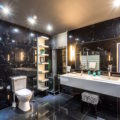New digital library of exemplar sustainable buildings from across the world launched
The World Green Building Council (WorldGBC) has launched a new digital case study library showcasing examples of the world’s most cutting-edge sustainable buildings.
Each case study demonstrates enhanced performance in relation to health benefits or achieve net zero operational carbon, as verified by established certification schemes, rating tools or other third-party verification.
Buildings and construction together account for 36% of global final energy use and 39% of energy-related carbon dioxide (CO2) emissions when upstream power generation is included. Additionally, people spend 90% of their time in buildings, and there is a consistent association between unhealthy indoor environments and negative human health impacts, for example exposure to damp and mould is recognised to raise likelihood of asthma attacks by 40%. Building operations, therefore, represent a significant opportunity to reduce energy consumption and carbon emissions, improve air quality and create healthier places for people and communities.
WorldGBC has launched the case study library in recognition of growing market demand to highlight the ‘best in class’ buildings that excel in key areas of sustainability, and the role of certification schemes to provide third party assurance of performance.
This ‘go-to’ resource for verified exemplar projects within the built environment globally will launch at USGBC’s Greenbuild conference in Atlanta on 19 November 2019. Following the launch, it will be open for new submissions via the website on a rolling basis.
Submissions are reviewed against qualification criteria, developed by WorldGBC with input of an advisory committee of development partners. This process is to ensure that each project featured in the library represents an outstanding example of sustainability in the built environment, as a net zero carbon building or across different areas of health and wellbeing.
Net zero carbon case studies are existing buildings or spaces that can demonstrate they have achieved high levels of energy efficiency and either generate or procure sufficient renewable energy to meet the building’s demand over 12 consecutive months. This can be demonstrated either through the use of Green Building Council or other market rating tools that certify net zero carbon performance, or by providing third party verified data to support the net zero claim.
Healthy case studies are existing buildings or spaces that can demonstrate they excel in the provision of features that enhance human health, as verified and certified using rating schemes demonstrating outstanding achievement of health elements of a holistic green building certification scheme, or achieve specific health-based certification, or demonstrate equivalent levels of performance using verified data.
The library also features industry “game changer” projects – those that have achieved the criteria for bothhealthy and net zero performance criteria – and information from the case studies about their specific features, lessons learned and additional useful project information. It is therefore a useful resource for sharing and learning about best practice approaches to achieving pioneering levels of sustainable performance.
An example of a “game changer” project is Floth’s office in Brisbane, Australia which has been certified as carbon neutral by the National Australian Built Environment Rating System (NABERS) standard, and which achieves exemplary performance for healthy impacts in both NABERS Internal Environment and the Green Building Council of Australia’s Green Star rating system.
CBRE’s Vancouver office is also included on the map for achieving Gold certification under the WELL building standard and for its multiple features that promote a healthy work environment.
Several buildings that have recently been awarded certification under DGNB’s Carbon Neutral Framework for demonstrating best practice in energy efficiency and a balance of renewable energy are also featured, including City Hall in Freiburg, Germany, the biggest surplus energy building in Europe.
Over time, the case study library will be developed to respond to the changing nature of sustainability and the impact of the WorldGBC global network of almost 70 Green Building councils, closely linked to the UN’s Global Goals. By keeping track of these projects, WorldGBC will be able to share insights about global trends in providing solutions to reducing the environmental impact of buildings, to help inform policymakers, designers, and developers about the feasibility, best practices, while promoting advanced sustainable building performance.
As a global network committed to achieving a sustainable built environment, I’m delighted to launch our new case study library. It showcases the most cutting-edge examples of sustainable building worldwide as verified by our local Green Building Councils. Buildings are a vital part of the solution to the climate crisis as they are the fastest, most viable and cost-effective means to achieve emissions reductions. Therefore, our case study library will be a valuable resource to further inspire commitment towards improving human health and eliminating the building and construction sector’s CO2 emissions to reach net zero before 2050.
Christina Gamboa, CEO of World Green Building Council.
Developed in partnership with DELOS, Integral Group and Saint-Gobain, this interactive digital resource is a joint initiative between two of WorldGBC’s global projects: Advancing Net Zero – accelerating uptake of net zero carbon to 100% by 2050 – and Better Places for People – accelerating market demand for sustainable buildings through demonstrating people-centred co-benefits.




